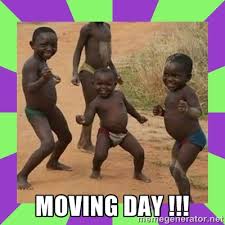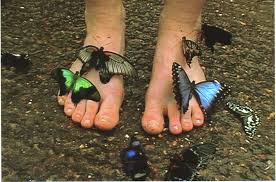Dancing is moving.
Doesn’t mean that moving is also dancing...
But if you do it gracefully, and possibly also rhythmic, even sometimes change in place and position, move more than one body part, and that perhaps even rhythmic on music... then it’s dance.
So it is not that difficult, anyone can learn it.
Fisherman, when a colleague after two hours of waiting replaced one foot:
"Hey, are you here to fish or to dance?"
Agreed, some have more feeling for rhythm and dance. For lots of colored fellows, it seems to go natural, like breathing. However, most white people need clear structures and learned figures and steps. It can be both. And it is 'dance' in each case. So you cannot actually do anything wrong. You can do it in a different way, but that is not wrong.
 Moving can range from relaxed and calm to spicy and grueling. That gives us the right to speak about dance sport. How hard you make it, depends mainly on yourself. It is a very social sport. You can do it together, with a partner, or with multiple dance partners. And you can also have fun for a long time. I've seen an elderly couple dancing a rumba. For them, it was probably already the 3,642ste time. I saw it for the first time... touching and beautiful and intimate. Also fragile, because of their age. To get tears in your eyes. Later in the evening I heard that they were already quiet over 80. And that she, if she wanted, yet could easily put her foot on his shoulder... It definitely helps you to remain in shape.
Moving can range from relaxed and calm to spicy and grueling. That gives us the right to speak about dance sport. How hard you make it, depends mainly on yourself. It is a very social sport. You can do it together, with a partner, or with multiple dance partners. And you can also have fun for a long time. I've seen an elderly couple dancing a rumba. For them, it was probably already the 3,642ste time. I saw it for the first time... touching and beautiful and intimate. Also fragile, because of their age. To get tears in your eyes. Later in the evening I heard that they were already quiet over 80. And that she, if she wanted, yet could easily put her foot on his shoulder... It definitely helps you to remain in shape.
The functions of dances are mostly positive, so in terms of self-confidence, assertiveness, stamina, agility, sensuality, social contacts. And that is a nice bonus in this hobby.
Dances we usually link to partying and clubbing, socializing, ambiance.
You can also see dance as a good relationship test. If you can learn to dance together, you learn a lot about each other. Although you can hear and see some arguing and discussion on and around the dance floor. However it is not a matter of being right or being provided tight, but to make together something beautiful and harmoniously.
Many dances are only briefly touched or almost not. For example, religious or battle dance, folk dance, individual dancing, whirling dervishes, healing or shaman dance, war dance, martial arts (capoeira), expression, ballet, folk dance, therapeutic dance, trance dancing, head banging, jumping, ritual dances, primitive dancing, oriental dancing, flamenco, folk ball... There is an incredibly exciting and wide variety. We are short about individual and company dance, and stick to partner dance.
We therefore limit ourselves to Western ' Social Dance ', social couple dancing.
That is basically the same as the standard or competition dances, and a number of other dances that we find amusing and can do also on parties and events. Without the straitjacket of regulations, rules and programs. Simply. Living dance.
There are ancient cave drawings on which dancing cavemen and Indians can be seen. The first dances in the course of the centuries have changed into, for example, group dancing, duo dancing and solo dances.
Dancing still evolves, there are fashion trends, ups and downs, touching hits, movies and TV programs that set trends... you can guess: dancing rarely stops... They change, adopt new elements, change name, rhythm, return to their roots. We're talking about living dance. Each description is a snapshot. What is important is your perception of your own dance.
"The only thing fans are doing is dreaming about someone else's life." (Babette Van Veen)
Dancing is fun. Social dance is fun.
 The word DANCE is derived from the French dancer, and the earlier dancier (ca. 1170), which also occurs in other Romance languages such as Provençal: dansar, Spanish: danzar, Italian: danzare.
The word DANCE is derived from the French dancer, and the earlier dancier (ca. 1170), which also occurs in other Romance languages such as Provençal: dansar, Spanish: danzar, Italian: danzare.
It is believed that the word has a Germanic origin, since it was used mainly in northern France, and it was a rather literary word around the Mediterranean Sea, next to the there more usual from of the Latin verb ballare 'dance'.
Ballare was the stem of the Italian diminutive of ballo: balletto (dance art), which is used in French for ballet: 'dance game, dance group' (1578).
Recognize also the word BAL for dance ball. Its roots go back to the Greek ballein "throwing, throwing himself, twisting, pivoting " to be used later as ballízein 'move back and forth, dancing". The derived Late Latin ballare (dance) was in French baler, then baller (dancing). Of these are also bale (1643) and Ball (1682) derived, also used figuratively for "turmoil, tumult, strife" (1785).
In that sense it still lives in Belgium, in expressions "there is always ball" (a variation on "the dolls are dancing”: always rumor).
This strain comes back in (balancing), ballad, ballerina, ballet, ballroom.
You cannot dance to music of the future (Hugo Tresinie)
